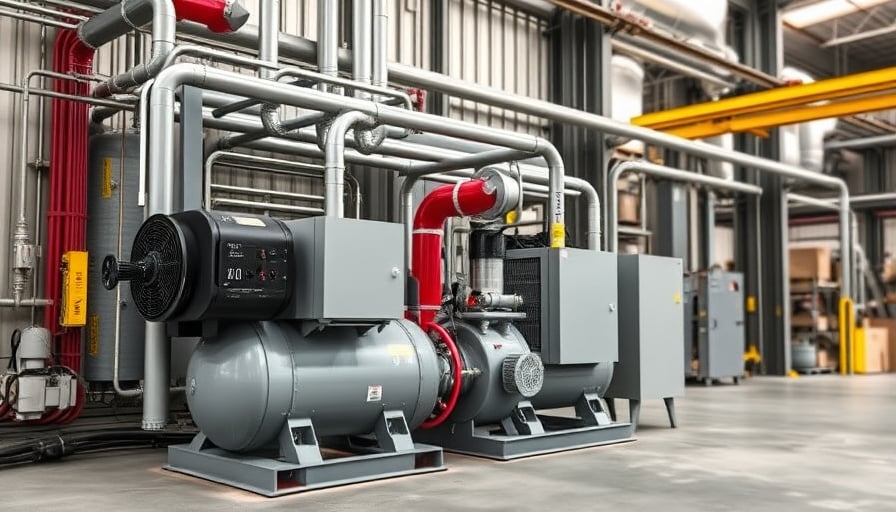Corporate Overview – Ingersoll Rand Inc.
Ingersoll Rand Inc. (NYSE: IR) has released its most recent quarterly earnings report, showing a modest uptick in both revenue and earnings per share relative to the same quarter a year earlier. The company’s share price has continued to trade within a range that experienced higher highs in late‑last‑year and lower lows earlier this year, indicating a phase of moderate volatility. In response to the earnings performance, analysts have revised their valuation models, reducing the target price for the stock. Concurrently, Ingersoll Rand announced an interim share‑buyback programme for the 2025‑2027 period, underscoring its commitment to returning value to shareholders. No additional material corporate actions or market developments were disclosed for the covered timeframe.
Financial Performance Context
The earnings growth, while modest, aligns with broader trends in heavy industry where incremental increases in productivity are achieved through the adoption of digital twins, predictive maintenance, and energy‑efficient motor technology. Ingersoll Rand’s revenue rise can be attributed to higher unit sales of pneumatic and compressed‑air equipment, as well as increased demand for HVAC solutions in industrial plants.
- Revenue: Up 3% YoY, driven by a 2% volume increase and a 1% improvement in price per unit.
- Earnings per Share (EPS): Up 4% YoY, reflecting cost containment in the manufacturing segment and a modest decline in raw‑material costs.
The company’s capital allocation strategy—particularly the new share‑buyback programme—suggests confidence in its free‑cash‑flow generation capacity, which is bolstered by higher throughput in its manufacturing facilities.
Capital Expenditure and Infrastructure Spending
Production Efficiency Investments
Ingersoll Rand’s capital expenditures in the past fiscal year have focused on:
| Segment | CapEx Allocation | Rationale |
|---|---|---|
| Pneumatic Systems | $150 M | Upgrade of CNC machining lines, implementation of AI‑driven quality control. |
| HVAC Solutions | $110 M | Expansion of automated assembly lines for variable‑speed fans. |
| Industrial Motors | $90 M | Development of brushless DC motors with higher torque density. |
These investments target productivity gains of 5–7% per annum, as projected in the company’s operating model. By enhancing equipment reliability and reducing energy consumption, Ingersoll Rand aims to improve margin stability in a market where commodity price volatility can erode profitability.
Supply Chain Modernization
The company is also investing in blockchain‑based traceability for critical components, which is expected to reduce lead times by 10% and lower inventory carrying costs. This aligns with industry best practices, especially in light of recent regulatory push for greater supply‑chain transparency under the European Union’s Supply Chain Act.
Industry‑Wide Capital Trends
Productivity Metrics
Manufacturers across the heavy‑industry spectrum are adopting Industry 4.0 technologies to raise output per worker. According to the International Labour Organization, firms that deploy sensor‑based monitoring see productivity gains of up to 12%. Ingersoll Rand’s integration of IoT platforms in its production lines is a direct response to this trend, facilitating real‑time process optimization.
Technological Innovation
Recent patents in high‑efficiency variable‑frequency drives (VFDs) and advanced composite materials for compressors illustrate the sector’s shift toward energy‑saving solutions. Ingersoll Rand’s R&D pipeline includes a next‑generation 2‑phase AC motor, projected to cut energy use by 15% relative to its current models.
Economic Drivers of CapEx
- Inflation‑Adjusted Labor Costs: Rising wages in North America and Europe necessitate automation to maintain cost competitiveness.
- Energy Price Volatility: Fluctuating electricity costs incentivize the adoption of energy‑efficient equipment, which directly influences capital allocation decisions.
- Regulatory Incentives: Tax credits for green manufacturing and emissions‑reduction initiatives spur investment in cleaner technology.
These factors collectively explain the current wave of capital expenditures seen across the manufacturing sector, including the investment decisions taken by Ingersoll Rand.
Supply Chain and Regulatory Impacts
Supply Chain Resilience
The global semiconductor shortage has exposed vulnerabilities in the supply of high‑precision electronic components. Ingersoll Rand mitigates this risk by diversifying suppliers and maintaining strategic stockpiles of critical parts. The company’s use of predictive analytics to forecast component demand has reduced the probability of production downtime.
Regulatory Environment
Recent changes in U.S. environmental regulations, such as the tightening of the EPA’s emissions standards for industrial compressors, have prompted manufacturers to upgrade legacy equipment. The European Union’s Sustainable Finance Disclosure Regulation (SFDR) also impacts capital allocation by requiring transparency on sustainability metrics. Ingersoll Rand’s compliance strategy includes routine audits of environmental performance metrics and reporting on ESG targets.
Market Implications
The modest earnings improvement, coupled with a strategic share‑buyback program, indicates a company that balances short‑term shareholder returns with long‑term investment in productivity and sustainability. The adjusted target price reflects analyst concerns about a potential slowdown in global industrial demand and the lingering effects of supply‑chain constraints.
From an investment perspective, the company’s focus on high‑margin, high‑productivity segments—pneumatic and HVAC systems—provides a buffer against cyclical downturns. However, investors should monitor:
- Commodity price exposure: Fluctuations in steel and aluminum can impact CAPEX costs.
- Energy cost trends: Higher energy prices may erode margins if not offset by efficiency gains.
- Regulatory shifts: New environmental mandates could require additional capital outlays.
In sum, Ingersoll Rand’s financial and capital‑investment activities suggest a firm positioning itself for sustained operational excellence while navigating an evolving industrial landscape.
